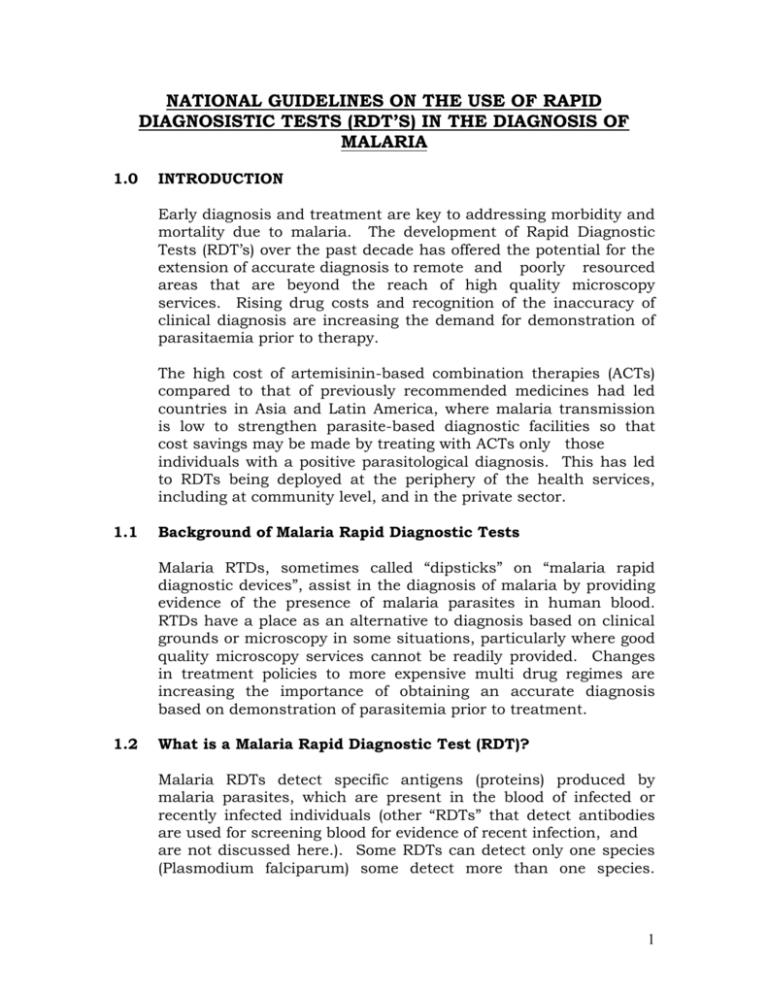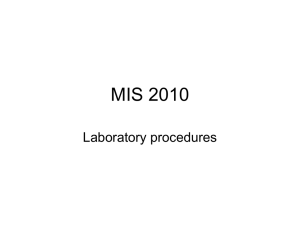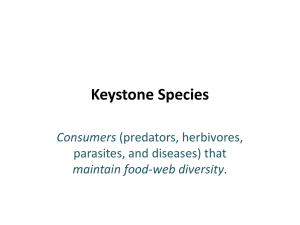National guidelines on the use of rapid diagnostic tests
advertisement

NATIONAL GUIDELINES ON THE USE OF RAPID DIAGNOSISTIC TESTS (RDT’S) IN THE DIAGNOSIS OF MALARIA 1.0 INTRODUCTION Early diagnosis and treatment are key to addressing morbidity and mortality due to malaria. The development of Rapid Diagnostic Tests (RDT’s) over the past decade has offered the potential for the extension of accurate diagnosis to remote and poorly resourced areas that are beyond the reach of high quality microscopy services. Rising drug costs and recognition of the inaccuracy of clinical diagnosis are increasing the demand for demonstration of parasitaemia prior to therapy. The high cost of artemisinin-based combination therapies (ACTs) compared to that of previously recommended medicines had led countries in Asia and Latin America, where malaria transmission is low to strengthen parasite-based diagnostic facilities so that cost savings may be made by treating with ACTs only those individuals with a positive parasitological diagnosis. This has led to RDTs being deployed at the periphery of the health services, including at community level, and in the private sector. 1.1 Background of Malaria Rapid Diagnostic Tests Malaria RTDs, sometimes called “dipsticks” on “malaria rapid diagnostic devices”, assist in the diagnosis of malaria by providing evidence of the presence of malaria parasites in human blood. RTDs have a place as an alternative to diagnosis based on clinical grounds or microscopy in some situations, particularly where good quality microscopy services cannot be readily provided. Changes in treatment policies to more expensive multi drug regimes are increasing the importance of obtaining an accurate diagnosis based on demonstration of parasitemia prior to treatment. 1.2 What is a Malaria Rapid Diagnostic Test (RDT)? Malaria RDTs detect specific antigens (proteins) produced by malaria parasites, which are present in the blood of infected or recently infected individuals (other “RDTs” that detect antibodies are used for screening blood for evidence of recent infection, and are not discussed here.). Some RDTs can detect only one species (Plasmodium falciparum) some detect more than one species. 1 Blood for the test is commonly obtained from a finger prick. RDTs are an alternative to diagnosis based on microscopy. When used correctly, malaria RDTs can provide a useful guide to the presence of clinically significant malaria infection caused by the species of parasite they are designed to detect. RDTs can help in case management, particularly when good quality microscopybased diagnosis is unavailable. 1.3 Mechanism of action of malaria rapid diagnostic tests RDTs are lateral flow “Immuno-chromatographic” antigen – detection tests, which rely on the capture of dye-labeled antibodies to produce a visible band on a strip of nitro-cellulose. With malaria RDTs, the dye labeled antibody first binds to a parasite antigen, and the resultant complex is captured on the strip by a band of bound antibody, forming a visible line (test line). A control line gives information on the integrity of the antibody-dye conjugate, but does not confirm the ability to detect parasite antigen. The first step of the test procedure involves mixing the patients blood with a lying agent in a test strip or well. This ruptures the red cells, releasing more parasite protein, labeled antibody, either in the well or on the strip, may then bind the target protein (antigen). The resulting mixture of blood products and antigen-labelled antibody complex then passes along the nitro-cellulose strip. This is facilitated partly by capillary action through the fiber-mesh of the strip, and partly by flushing with a fluid buffer placed behind the blood. It passes over the test and control bands. The free, labeled antibody will capture the parasite antigen if present which will in turn be captured by the test-band antibody. The accumulation of microscopic dye particles on the thin band produces a visible line if sufficient antigen – labeled antibody complex is present. The control band will come visible as sufficient labeled antibody accumulates on the line. Antibody (or antigen) bound to the strip captures labeled antibodies which failed to bond to antigen from the patient’s blood. A visible control line indicates that labeled antibody has traversed the full length of the strip, past the test line, and that at least some free antibody remains conjugated to 2 the dye and that some of the capturing properties of the antibodies remain intact. The intensity of the test band will vary with the amount of antigen present, at least at low parasite densities (antigen concentration), as this will determine the amount of dye particles which will accumulate on the line. The control band intensity may decrease at higher parasite densities, as much of the labeled antibody will have been captured by the test band before reaching the control. 1.4 Types of Malaria Rapid Diagnostic Tests The three main groups of antigens detected by commercially available RDTs are: Histamine - rich protein 2 (HRP2), specific to P. falciparum. Plasmodium lactate dehydrogenase (pLDH) currently used in products that include P. falciparum – specific, pan-specific, and P.vivax specific pLDH antibodies. Aldolase (pan specific). Target antigens of commercially available malaria rapid diagnostic tests. p. falciparum specific HRP2 + pLDH + Pan specific (all species) + P. vivax – specific + Aldolase + Most commercial products include antibodies to: HRP2 alone (P. falciparum) HRP2 and aldolase (distinguishing P. falciparum/mixed infection from non-falciparum alone). 3 Falciparum – specific LDH and pan-specific LDU (distinguishing P. faciparum mixed infection from non-falciparum alone). HRP2 and pan-specific LDH. HRP2, pan-specific pLDH and vivax-specific pLDH or Pan-specific aldolase only. RDT detecting both falciparum – specific and non-falciparum (or panspecific) target antigens are commonly called combination or “combo” tests. The products come in various formats like: Plastic cassette Card Dipstick Hybrid cassette-dipsticks. In areas where only falciparum malaria occurs, or non-falciparum malaria rarely occurs without co-infection of P.falciparum, RDTs that detect only P. falciparum are generally preferable on grounds of lower cost. Most (or all) commercially – available RDTs in this category detect HRP2. 1.5 Advantages and Disadvantages of HRP2 RDTs Advantages: No need for laboratory facilities Simplicity and rapidity of the tests. No need for electricity or laboratory equipment. Minimal requirement for training (basic skills acquired in 1 day). Acceptable levels of sensitivity and specificity, and Feedback of conditions of use can be provided to manufactures. Disadvantages: More expensive than microscopy. Limitations in species identification, and Persistent positively of HRP2 tests after effective treatment. 1.6 Transportation chain and storage of RDTs. 1.6.1 Transportation: Maintaining a “cool chain”. The development of a “cool chain” for shipment and storage of RDTs is essential. 4 Environmental conditions during transportation can be extreme, and every precaution should be taken to avoid RDTs being kept in conditions of excessive heat or humidity. Transport from the manufacturer and road transport within a country, are particularly vulnerable times. Avoid leaving RDTs in vehicles parked in the sun. 1.6.2 Stability and Storage: Proteins are denatured by heat, and RDTs are thus susceptible to being inactivated through exposure to excessive heat. Exposing RDTs to temperatures of 0ºC and below may also cause damage. Most manufacturers recommend RDT storage between 2ºC and 30ºC. Expiry dates are generally set according to these conditions. If kits are stored at temperatures exceeding the recommended limits, it is likely that the shelf life of the RDTs will be reduced and sensitivity lost prior to the expiry date. All RDTs should remain sealed until immediately before use. If stored in a cool environment, they should be allowed to reach room temperature before being opened to avoid condensation forming on the strip. 1.7 Who should perform RDTs Most of the current RDTs are designed for ease of use. It seems clear that it is possible to train unskilled – but willing – individuals to become reliable competent in the use of RDTs. With adequate training, (usually 1 day), Health Care Auxilliary staff, Family Welfare Educators, nurses, and doctors, can use RDTs effectively, achieving acceptable high sensitivity and specificity, comparable with the results obtained by an experienced microscopist. 5 2.0 PROCUREMENT OF RDTs 2.1 Important factors to be considered when choosing the RDTS: Sensitivity should be near 95% at 100 parasites /ul for detection of p.falciparum. Specificity should be close to 90%. A minimum shelf of 18 months to two years is the appropriate requirement. In most remote endemic areas, storage temperatures above 30 will be unavoidable, hence temperature should range from 2 to 30 degrees Centigrade. RDTS for field use in tropical conditions should be individually packaged in moisture- proof envelopes, which should remain sealed until immediately prior to use. 2.2 The procurement unit should request the following from suppliers /manufactures doing the tendering process. ISO certification and GMP procedures Real –time temperature stability data on the product. Evidence of successful operational use or good quality field trial data on the product. Provision of sample product for assessment and testing for ease of use (user- friendliness). . Box sizes appropriate to the rate of use of tests in the intended area and to minimize uncontrolled storage and need to split boxes. 2.3 Evaluation and report on RDTs conduced in 2006 is shown in appendix 1. 6 QUALITY ASSURANCE OF RDTS 3.0 INTRODUCTION Variation in RDT accuracy in published trials and operational experience underline the need for an accurate transport system for monitoring the accuracy of RDTs after release by the manufacture. The Development of a comprehensive quality assurance scheme is essential to ensure that test quality is maintained, reducing the likelihood of misdiagnosis and maintaining confidence of health service providers and consumers. In time such a scheme will provide standardized evidence of test performance to guide purchasing and development. 3.1 Malaria RDTs are affected by various conditions of manufacture, storage and use that can impair their accuracy and reliability. The Global initiative to scale up introduction of RDTs to aid in the management of malaria, especially in the locations where microscopic based diagnosis is unavailable therefore requires a system in place to assure that service quality is guaranteed. 3.2 QA is defined as a total process both in and outside the lab including performance standards, good lab practice and management skills to achieve and maintain a quality service and provide for continuing improvement. 3.3 The purpose of QA is to provide reliable, relevant, timely test results that are interpreted correctly thereby increasing efficiency, effectiveness, enhancing patient satisfaction and decreasing costs brought about by misdiagnosis. 3.4 This is increasingly important with the advert of combination therapies and their higher associated costs. A QA process for malaria RDTs should aim to ensure high accuracy of tests in the hands of end-users. This will include both monitoring of the technical standard of the RDTs, process to minimize environmental insult training and monitoring of preparation and interpretation by end- users. 3.5 Quality control must be practical, achievable and affordable. There has to be a system for laboratory- based assessment of performance of RDTs throughout their shelf- life and beyond. 7 QUALITY CONTROL AND THE END USER: 4.1 The degree to which individual countries /malaria control programmes implement RDT/QA schemes will depend on practical and organizational issues. 4.2 The QA focus at this level should concentrate on initial training, supervision and continuous education so that personnel working remote areas achieve and retain competence and motivation. Training should not only include test procedure methodology but also trouble shooting. 4.3 TRAINING The QA concept includes the notion that the personnel have sufficient education, training and experience to permit the proper performance of duties. This later concept becomes more difficult to implement at lower levels of the chain. A QA scheme is only as strong as the weakest link in the chain; therefore everyone involved should receive appropriate and rapid feedback to maintain commitment to the programme. The importance of end user performance to the accuracy of malaria RDT cannot be over emphasized. Ideally training may consists of instructions received on the job but most importantly through formal training. The following should be emphasized during training and after implementation: Exercising diligence in the performance of assigned duties. Maintaining a required level of proficiency. Exercising judgment /seeking advice in reacting to unforeseen circumstances. Keeping accurate records. Requesting necessary training. Honesty and Motivation 4.4 To maintain a quality service, the initial training must be supplemented by regular supervision and in-service courses. An organized system of supervision, that is periodic visits by experienced staff, especially to peripheral areas will provide a 8 mechanism by which problems are discussed, and resolved and anomalies in reported results are investigated. 4.5 Supervisors themselves must be adequately trained so that supervision is carried out in a helpful, constructive way and is not just a critical analysis. 4.6 Training on performance and interpretation of results shall be done annually through the period of September to November and is a continuous process. 4.7 If need be training will be done in the local language. 4.8 TRANSPORT AND STORAGE OF RDTS. (SEE PARAGRAPH 1.6.1) These demand a ‘cool chain’ transport and storage, and are important for: Careful coordination of transport to avoid unnecessary delays between C.M.S. and the end user. Avoidance of exposure to direct sunlight. Use of air conditioned /refrigeration storage where possible (frequently impossible in peripheral areas.) Temp monitoring of storage facilities. Rejection of RDTs where packaging is significantly damaged and it is likely that moisture- proofing of envelops or canisters is lost. Use of cooler boxes and icepacks for transport to remote areas. 5.0. QUALITY CONTROL 5.1 RDTs and slides should be run in parallel with particular emphasis on good record keeping so as to compare results. 5.2 Records will be inspected on monthly basis to see if any correlation or disparities. 5.3 Henceforth communication between supervisor and end –user will be initiated. 5.4 Evaluation of the new-kits will be done every 24 months. 9 6.0 OTHER ISSUES 6.1 Operational problems that might be encountered include the following: Supply delays, resulting in stock outs Delayed disownments and limitation of funds for procurement. Delays between peripheral and control levels in re-ordering of supplies. Transport /distribution problems (no temperature control for RDTS and no fuel for vehicles). Poor storage conditions at the peripheral levels. Difficulty in ordering specific product and consumer pressure for treatment despite a negative RDT result. 7.0 RECOMMENDATION It is recommended that one or two people should be designated to coordinate RDT QA at a national level, coordinating transport, storage, provision of samples for testing, and with oversight of training and monitoring of users. 10 Appendix 1 EVALUATION REPORT OF MALARIA RAPID DIGNOSTIC TEST (RDTS) 1.0 INTRODUCTION Parasitological confirmation of clinical diagnosis in malaria infections should be part of good clinical practice to improve the quality of care. However, where microscopy is not possible, Rapid diagnostic test (RDTs) should be used and appropriate Quality Assurance Systems be established. On this basic fact, we asked the suppliers to submit the malaria rapid diagnostic kits for evaluation. These kits were of two types: RDT Specifically detecting plasmodium falciparum infections only RDT detecting both falciparum- specific and non-falciparum (or panspecific commonly called combination or ‘combo’ tests. Where plasmodium falciparum is the predominant species (>90%),RDTs that can detect only p.falciparum are appropriate. In areas where P. vivax accounts for a significant proportion of the cases of malaria disease, a test that detects falciparum plus pan-malaria antigens or falciparum species is preferable. 2.0 TYPES OF KITS SUBMITTED Kits that were specific for plasmodium falciparum detection included the following: 1. 2. 3. 4. 5. 6. 7. 8. 9. Vision Bioteck- currently in use. Paracheck- ORCHID. Malaria Quick test- Cypress diagnostics. Care start. Core-Malaria PF. Smart check. Advantage Malaria card. Forest fast. NEOBIO Malascan. Kits that were pan- specific (combo kits) included the following: 1. 2. Hexagon –Human. Malaria Total Quick test –Cypress Diagnonstics. 11 3. Parascreen –Zephyr Biomedical 3.0 FACTORS CONSIDERED Important considerations involved choosing an RDT include: Sensitivity and specificity. Ideally, detection of parasites antigens by RDTS should be at least as sensitive as detection of parasite by microscopy, 95c% sensitivity at a parasite density of 100/ul of blood is recommended. Stability and storage. - Ease of use - - Proteins are denatured by heat, and RDTs are thus susceptible to being inactivated through exposure to excessive heat. Exposing RDTs to temperatures below 0 degrees Centigrade and below may also cause damage. High humidity will also adversely affects RDTs. It is important that RDTs have a reasonably long shelf –life. WHO recommends a minimum shelf –life of 18 months to 2 years. This impacts on sensitivity and stability. One of the prerequisites for the acceptability of RDTs for use in the field is ease of use, and most current RDTs are designed to ensure this. With adequate training, it is expected that village malaria workers and health volunteers, medical assistants and nurse aids can use RDTs effectively, achieving similar acceptable high sensitivity and specificity. Cost This will be evaluated when the suppliers’ bids for the item during tender procedures. 4.0 FINDINGS The following kits were positively recommended for use. 1. Vision Bioteck. 2. Paracheck –ORCHID. 3. Malaria Quick test- Cypress Diagnostics. 12 4. 5. 6. 7. 8. Smartcheck . Advantage Malaria card. Care start. Core- Malaria PF. Hexagon (Combo) - Human. The fortress fast was not evaluated due to low infection malaria rate reported by the facility where it was sent. 5.0 CONCLUSION The suppliers whose kits have been recommended will be informed so that they can bid for the product during the tender. Report complied by: Dr I. M. Mtoni - Consultant Microbiologist- NHL Mr T.J. Senosi NHL Mr T.R Bowe Technicians- CMS - Scientist and Technical SupervisorChief Medical Laboratory 30th January 2007 13








